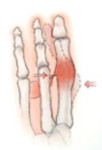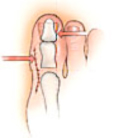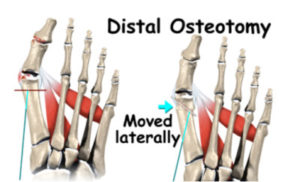
Most bunions can be treated without surgery. But when nonsurgical treatments are not enough, foot surgery can relieve your pain, correct any related foot deformity or hallux valgus, and help you resume your normal activities.
Having a better understanding of the causes and symptoms of bunion can help you take preventive measures and decide on what treatment to undertake. An orthopaedic surgeon can help you decide if bunion surgery is the best option for you.
Is Bunion Foot Surgery For You?
If nonsurgical treatment fails, you may want to consider surgery. Many studies have found that 85 to 90 percent of patients who undergo bunion surgery are satisfied with the results.
Reasons that you may benefit from bunion foot surgery commonly include:
- Severe foot pain that limits your everyday activities, including walking and wearing reasonable shoes. You may find it hard to walk more than a few blocks (even in athletic shoes) without significant pain.
- Chronic big toe inflammation and swelling that doesn’t improve with rest or medications.
- Toe deformity-a drifting in of your big toe toward the small toes known as hallux valgus.
- Toe stiffness-inability to bend and straighten your toe.
- Failure to obtain pain relief from nonsteroidal anti-inflammatory drugs. Their effectiveness in controlling toe pain varies greatly from person to person.
- Failure to substantially improve with other treatments such as a change in shoes and anti-inflammatory medication.
As you explore bunion surgery, be aware that so-called “simple” or “minimal” surgical procedures are often inadequate “quick fixes” that can do more harm than good. And beware of unrealistic claims that surgery can give you a “perfect” foot. The goal of surgery is to relieve as much pain, and correct as much deformity as is realistically possible. It is not meant to be cosmetic.
Types of Bunion Surgery
Orthopaedic surgeons use many different surgical procedures to treat bunions. The common goal of these procedures is to realign the joint, relieve pain, and correct deformity. These bunion surgery procedures include:
Repair of the Tendons and Ligaments Around the Big Toe

These tissues may be too tight on one side and too loose on the other, creating an imbalance that causes the big toe to drift toward the others. Often combined with an osteotomy, this procedure shortens the loose tissues and lengthens the tight ones.
Arthrodesis

Removal of the damaged joint surfaces, followed by the insertion of screws, wires, or plates to hold the surfaces together until it heals. Used for patients with severe bunions, severe arthritis, and when other procedures have failed.
Resection Arthroplasty

Removal of the damaged portion of the joint, used mainly for patients who are older, have had previous bunion surgery, or have severe arthritis. This creates a flexible “scar” joint.
Osteotomy
The surgical cutting and realignment of the joint. Your orthopaedic surgeon will choose the procedure best suited to your condition.

Realistic Expectations About Bunion Foot Surgery
An important factor in deciding whether to have bunion foot surgery is understanding what the procedure can and can not do. The vast majority of patients who undergo bunion surgery experience a dramatic reduction of foot pain after surgery, along with a significant improvement in the alignment of their big toe.
Bunion surgery will not allow you to wear a smaller shoe size or narrow-pointed shoes. In fact, you will have some shoe restrictions for the rest of your life. Always follow the recommendations for shoe fit to prevent bunions.
Remember that the main cause of the bunion deformity is a tight fitting shoe. If you return to that type of shoe wear, your bunion will reappear.
Your Bunion Foot Surgery
Almost all bunion surgery is done on an outpatient basis. You will most likely be asked to arrive at the hospital or surgical center one or two hours prior to surgery.
After admission, you will be evaluated by a member of the anesthesia team. Most bunion surgery is performed under ankle block anesthesia, in which your foot is numb, but you are awake. General or spinal anesthesia is used occasionally. The anesthesiologist will stay with you throughout the procedure to administer other medications, if necessary, and to make sure you are comfortable.
The surgery takes about one hour. Afterwards, you will be moved to the recovery room. You will be ready to go home in one or two hours.
Possible Complications After Bunion Foot Surgery
Fewer than 10 percent of patients experience complications from bunion surgery. Possible complications can include infection, recurrence of the bunion, nerve damage, and continued pain.
Here are some tips on bunion recovery after surgery. If complications occur, they are treatable but may affect the extent of your full recovery.
Looking For A Reliable Foot & Ankle Orthopaedic Specialist?
Fast Medical Attention, Transparent Fees
Make an appointment for comprehensive care for your Foot & Ankle problems!
